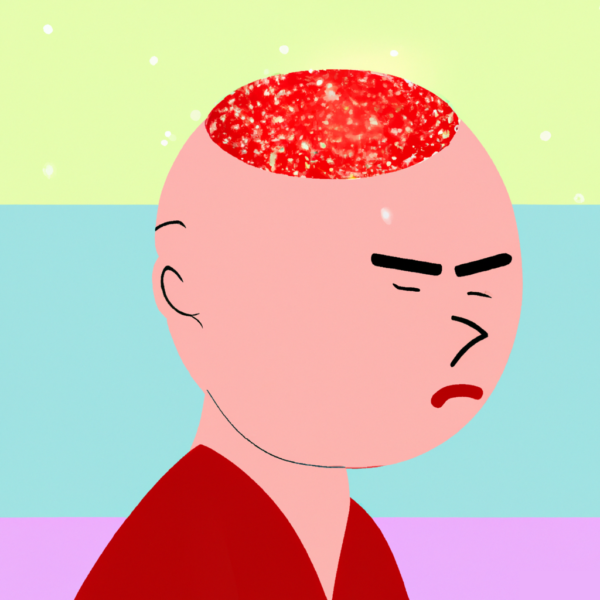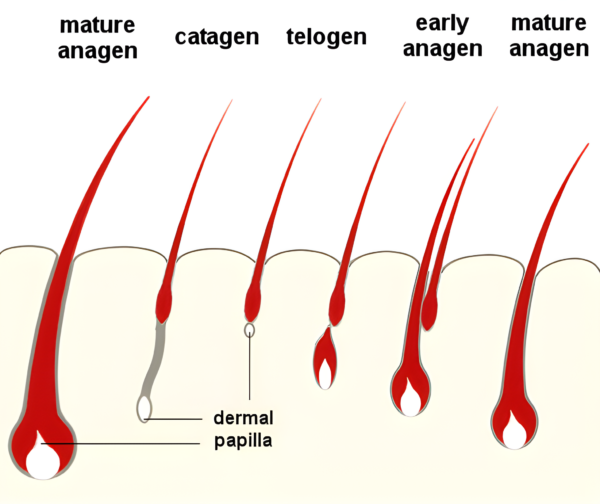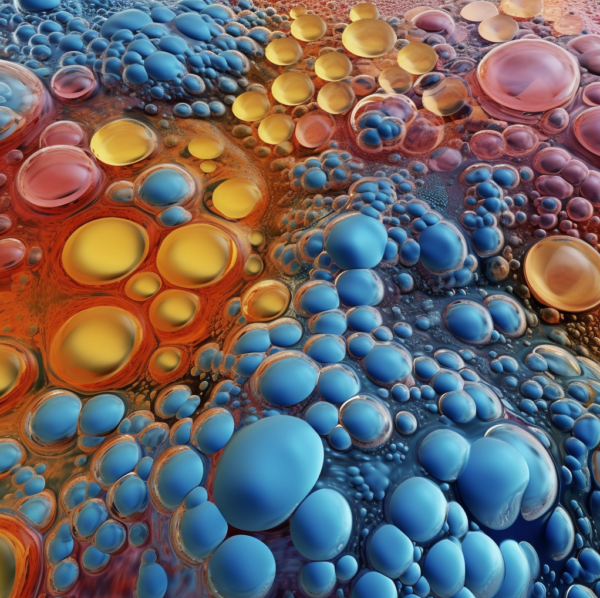Androgenetic alopecia (AGA), commonly known as male or female pattern baldness, is a prevalent form of hair loss affecting millions worldwide. The pathogenesis of AGA is primarily attributed to genetic predisposition and the influence of androgens. However, recent research has begun to explore the potential role of environmental factors, particularly ultraviolet (UV) radiation, in the progression of AGA, raising the question: Is AGA aggravated by over exposure to UV light from the sun?
Photoaggravated dermatoses are skin conditions that worsen with exposure to UV radiation. The skin, particularly the scalp, is continually exposed to UV radiation, which can induce inflammatory responses, DNA damage in cells, and oxidative stress in the sunlight exposed skin. These factors are known to contribute to various skin conditions, including photoaging, skin cancers, and potentially, AGA.
The potential link between UV radiation and AGA can be drawn from the understanding of hair follicle biology and the effects of UV radiation on the skin. Hair follicles undergo cyclical phases of growth (anagen), regression (catagen), and rest (telogen). In AGA, the anagen phase is progressively shortened, leading to miniaturization of hair follicles and eventual hair loss. UV radiation, particularly UVB, is known to induce apoptosis of keratinocytes, the predominant cell type in hair follicles. This could potentially disrupt the hair growth cycle and contribute to the progression of AGA.
Furthermore, UV radiation can induce the production of reactive oxygen species (ROS), leading to oxidative stress. Oxidative stress can damage cellular structures, including DNA, and disrupt cellular functions. In the context of AGA, oxidative stress could potentially damage hair follicle cells and disrupt the hair growth cycle.
UV radiation also induces the production of inflammatory mediators, such as cytokines and enzymes called matrix metalloproteinases (MMPs). MMPs break down collagen in the skin making it thinner and less able to support cell growth. Inflammation is a key factor in the pathogenesis of AGA, with increased levels of inflammatory mediators observed in balding scalp biopsies. The induction of inflammation by UV radiation could potentially exacerbate this inflammatory response and contribute to the progression of AGA.
Despite these potential links, direct evidence linking UV radiation to AGA is limited. Most studies on the effects of UV radiation on the skin do not specifically focus on the scalp or hair follicles. Furthermore, the role of UV radiation in AGA is complicated by the protective role of hair in shielding the scalp from UV radiation. In AGA, hair loss would increase the exposure of the scalp to UV radiation, potentially exacerbating the condition.
A study by Lu et al., titled “Profiling the response of human hair follicles to ultraviolet radiation,” arguably provides the best insight into the effects of UV radiation on hair follicles currently available. The researchers isolated hair follicles from scalp biopsies and put them into tissue culture media to study them. They found that UVB irradiation could induce apoptosis in the upper hair follicle, exerting either stimulatory or inhibitory effects in vivo, depending on the wavelength of UV light. The study also revealed that hair shaft elongation was significantly inhibited under UVB irradiation of 50 mJ cm−2 compared to sham-irradiated control follicles. This inhibition was observed as early as day 5, with increasing levels of significance reached at later time points.
The researchers also observed a linear dose-dependent increase in DNA fragmentation in human hair follicles, while cell proliferation rapidly declined after low UVB irradiation. Cytotoxicity, indicated by increased lactate dehydrogenase (LDH) release into the culture medium, occurred only at higher UVB doses. The study also found that specific pathways of apoptosis are induced only at lower UVB doses. These findings suggest that UV radiation can have a significant impact on hair follicle biology, potentially contributing to conditions such as AGA. However, this is only one study and it is unclear if the same result would occur to hair follicles embedded in the scalp skin.
In conclusion, while there are plausible mechanisms through which UV radiation could contribute to the progression of AGA, direct evidence is currently lacking. Further research is needed to elucidate the role of UV radiation in AGA and to determine whether AGA is indeed a photoaggravated dermatosis. This could potentially open up new avenues for the prevention and treatment of AGA, such as the use of sun protection strategies or antioxidants to mitigate the effects of UV radiation.
Bibliography
11711645 {11711645:HXIKVAR2},{11711645:IEKW4MM2},{11711645:ZMNGZGBH},{11711645:RPJNBACE},{11711645:UBABJNTW},{11711645:28UWEVRN},{11711645:PR6DU2ED},{11711645:APGQX3CP} 1 vancouver 50 date asc 130 https://www.keratin.com/wp-content/plugins/zotpress/ %7B%22status%22%3A%22success%22%2C%22updateneeded%22%3Afalse%2C%22instance%22%3Afalse%2C%22meta%22%3A%7B%22request_last%22%3A0%2C%22request_next%22%3A0%2C%22used_cache%22%3Atrue%7D%2C%22data%22%3A%5B%7B%22key%22%3A%22HXIKVAR2%22%2C%22library%22%3A%7B%22id%22%3A11711645%7D%2C%22meta%22%3A%7B%22creatorSummary%22%3A%22Tr%5Cu00fceb%22%2C%22parsedDate%22%3A%222003%22%2C%22numChildren%22%3A0%7D%2C%22bib%22%3A%22%3Cdiv%20class%3D%5C%22csl-bib-body%5C%22%20style%3D%5C%22line-height%3A%201.35%3B%20%5C%22%3E%5Cn%20%20%3Cdiv%20class%3D%5C%22csl-entry%5C%22%20style%3D%5C%22clear%3A%20left%3B%20%5C%22%3E%5Cn%20%20%20%20%3Cdiv%20class%3D%5C%22csl-left-margin%5C%22%20style%3D%5C%22float%3A%20left%3B%20padding-right%3A%200.5em%3B%20text-align%3A%20right%3B%20width%3A%201em%3B%5C%22%3E1.%3C%5C%2Fdiv%3E%3Cdiv%20class%3D%5C%22csl-right-inline%5C%22%20style%3D%5C%22margin%3A%200%20.4em%200%201.5em%3B%5C%22%3ETr%26%23xFC%3Beb%20RM.%20Is%20androgenetic%20alopecia%20a%20photoaggravated%20dermatosis%3F%20Dermatology.%202003%3B207%284%29%3A343%26%23x2013%3B8.%3C%5C%2Fdiv%3E%5Cn%20%20%20%3C%5C%2Fdiv%3E%5Cn%3C%5C%2Fdiv%3E%22%2C%22data%22%3A%7B%22itemType%22%3A%22journalArticle%22%2C%22title%22%3A%22Is%20androgenetic%20alopecia%20a%20photoaggravated%20dermatosis%3F%22%2C%22creators%22%3A%5B%7B%22creatorType%22%3A%22author%22%2C%22firstName%22%3A%22Ralph%20M.%22%2C%22lastName%22%3A%22Tr%5Cu00fceb%22%7D%5D%2C%22abstractNote%22%3A%22Progressive%20thinning%20of%20the%20scalp%20hair%20in%20androgenetic%20alopecia%20%28AGA%29%20results%20in%20a%20gradual%20decline%20in%20natural%20protection%20of%20the%20scalp%20from%20ultraviolet%20radiation%20%28UVR%29.%20A%20number%20of%20pathologic%20conditions%20of%20the%20scalp%20are%20evidently%20related%20to%20UVR%2C%20particularly%20photosensitive%20diseases%20and%20disorders%20of%20the%20chronically%20photodamaged%20bald%20scalp.%20The%20most%20important%20chronic%20effects%20of%20UVR%20are%20photocarcinogenesis%20and%20solar%20elastosis.%20Besides%20these%2C%20erosive%20pustular%20dermatosis%20and%20%27red%20scalp%27%20are%20distinct%20disorders%20peculiar%20to%20the%20balding%20scalp.%20While%20the%20consequences%20of%20sustained%20UVR%20on%20the%20unprotected%20scalp%20are%20well%20appreciated%2C%20the%20effects%20of%20UVR%20on%20hair%20loss%20have%20widely%20been%20ignored.%20However%2C%20clinical%20observations%20and%20theoretical%20considerations%20suggest%20that%20UVR%20may%20have%20negative%20effects%3A%20acute%20telogen%20effluvium%20from%20UVR%20has%20been%20described%2C%20and%20the%20production%20of%20porphyrins%20by%20Propionibacterium%20sp.%20in%20the%20pilosebaceous%20duct%2C%20with%20photoactivation%20of%20porphyrins%20leading%20to%20oxidative%20tissue%20injury%2C%20has%20been%20implicated%20in%20follicular%20microinflammation.%20Alternatively%2C%20keratinocytes%20themselves%20may%20respond%20to%20physicochemical%20stress%20from%20UVR%2C%20besides%20irritants%20and%20pollutants%2C%20by%20producing%20radical%20oxygen%20species%20and%20nitric%20oxide%20and%20by%20releasing%20proinflammatory%20cytokines%2C%20eventually%20leading%20to%20injury%20of%20the%20putative%20site%20of%20follicular%20stem%20cells%20in%20the%20superficial%20portion%20of%20the%20hair%20follicle.%20Since%20all%20of%20these%20processes%20involved%20in%20hair%20loss%20share%20the%20common%20feature%20that%20they%20are%20induced%20or%20exacerbated%20by%20exposure%20to%20sunlight%2C%20it%20is%20proposed%20that%20AGA%20is%20a%20photoaggravated%20dermatosis%20that%20requires%20photoprotection.%22%2C%22date%22%3A%222003%22%2C%22language%22%3A%22eng%22%2C%22DOI%22%3A%2210.1159%5C%2F000074111%22%2C%22ISSN%22%3A%221018-8665%22%2C%22url%22%3A%22%22%2C%22collections%22%3A%5B%22QXACZBRV%22%5D%2C%22dateModified%22%3A%222023-05-19T16%3A01%3A50Z%22%7D%7D%2C%7B%22key%22%3A%22ZMNGZGBH%22%2C%22library%22%3A%7B%22id%22%3A11711645%7D%2C%22meta%22%3A%7B%22creatorSummary%22%3A%22Trueb%22%2C%22parsedDate%22%3A%222005%22%2C%22numChildren%22%3A0%7D%2C%22bib%22%3A%22%3Cdiv%20class%3D%5C%22csl-bib-body%5C%22%20style%3D%5C%22line-height%3A%201.35%3B%20%5C%22%3E%5Cn%20%20%3Cdiv%20class%3D%5C%22csl-entry%5C%22%20style%3D%5C%22clear%3A%20left%3B%20%5C%22%3E%5Cn%20%20%20%20%3Cdiv%20class%3D%5C%22csl-left-margin%5C%22%20style%3D%5C%22float%3A%20left%3B%20padding-right%3A%200.5em%3B%20text-align%3A%20right%3B%20width%3A%201em%3B%5C%22%3E1.%3C%5C%2Fdiv%3E%3Cdiv%20class%3D%5C%22csl-right-inline%5C%22%20style%3D%5C%22margin%3A%200%20.4em%200%201.5em%3B%5C%22%3ETrueb%20RM.%20Aging%20of%20hair.%20J%20Cosmet%20Dermat.%202005%3B4%282%29%3A60%26%23x2013%3B72.%3C%5C%2Fdiv%3E%5Cn%20%20%20%3C%5C%2Fdiv%3E%5Cn%3C%5C%2Fdiv%3E%22%2C%22data%22%3A%7B%22itemType%22%3A%22journalArticle%22%2C%22title%22%3A%22Aging%20of%20hair%22%2C%22creators%22%3A%5B%7B%22creatorType%22%3A%22author%22%2C%22firstName%22%3A%22Ralph%20M%22%2C%22lastName%22%3A%22Trueb%22%7D%5D%2C%22abstractNote%22%3A%22%22%2C%22date%22%3A%2206%5C%2F2005%22%2C%22language%22%3A%22en%22%2C%22DOI%22%3A%2210.1111%5C%2Fj.1473-2165.2005.40203.x%22%2C%22ISSN%22%3A%221473-2130%2C%201473-2165%22%2C%22url%22%3A%22%22%2C%22collections%22%3A%5B%225EEQ884B%22%5D%2C%22dateModified%22%3A%222023-05-17T21%3A22%3A05Z%22%7D%7D%2C%7B%22key%22%3A%22PR6DU2ED%22%2C%22library%22%3A%7B%22id%22%3A11711645%7D%2C%22meta%22%3A%7B%22creatorSummary%22%3A%22Verma%20and%20Wollina%22%2C%22parsedDate%22%3A%222009%22%2C%22numChildren%22%3A0%7D%2C%22bib%22%3A%22%3Cdiv%20class%3D%5C%22csl-bib-body%5C%22%20style%3D%5C%22line-height%3A%201.35%3B%20%5C%22%3E%5Cn%20%20%3Cdiv%20class%3D%5C%22csl-entry%5C%22%20style%3D%5C%22clear%3A%20left%3B%20%5C%22%3E%5Cn%20%20%20%20%3Cdiv%20class%3D%5C%22csl-left-margin%5C%22%20style%3D%5C%22float%3A%20left%3B%20padding-right%3A%200.5em%3B%20text-align%3A%20right%3B%20width%3A%201em%3B%5C%22%3E1.%3C%5C%2Fdiv%3E%3Cdiv%20class%3D%5C%22csl-right-inline%5C%22%20style%3D%5C%22margin%3A%200%20.4em%200%201.5em%3B%5C%22%3EVerma%20SB%2C%20Wollina%20U.%20Ultraviolet%20light-induced%20leukoderma%20of%20the%20scalp%20associated%20with%20androgenetic%20alopecia%3A%20senescent%20actinic%20depigmentation%20of%20the%20scalp.%20J%20Cutan%20Med%20Surg.%202009%3B13%285%29%3A262%26%23x2013%3B5.%3C%5C%2Fdiv%3E%5Cn%20%20%20%3C%5C%2Fdiv%3E%5Cn%3C%5C%2Fdiv%3E%22%2C%22data%22%3A%7B%22itemType%22%3A%22journalArticle%22%2C%22title%22%3A%22Ultraviolet%20light-induced%20leukoderma%20of%20the%20scalp%20associated%20with%20androgenetic%20alopecia%3A%20senescent%20actinic%20depigmentation%20of%20the%20scalp%22%2C%22creators%22%3A%5B%7B%22creatorType%22%3A%22author%22%2C%22firstName%22%3A%22Shyam%20B.%22%2C%22lastName%22%3A%22Verma%22%7D%2C%7B%22creatorType%22%3A%22author%22%2C%22firstName%22%3A%22Uwe%22%2C%22lastName%22%3A%22Wollina%22%7D%5D%2C%22abstractNote%22%3A%22BACKGROUND%3A%20Human%20scalp%20skin%20is%20normally%20protected%20from%20sunlight%20and%20ultraviolet%20radiation%20by%20the%20presence%20of%20hair.%20When%20hair%20loss%20occurs%2C%20for%20example%2C%20in%20androgenetic%20alopecia%2C%20this%20protective%20factor%20declines.%5CnOBJECTIVE%3A%20We%20report%20a%20series%20of%2010%20type%20IV%20and%20V%20skin%20patients%20with%20a%20male%20predominance%20%2860-85%20years%29.%20All%20patients%20suffered%20from%20androgenetic%20alopecia%20starting%20from%20the%20age%20of%20around%2040%20to%2045%20years.%20They%20all%20noticed%20asymptomatic%2C%20well-defined%2C%20depigmented%20macules%2C%20which%20were%20seen%20only%20in%20areas%20that%20have%20been%20afflicted%20by%20androgenetic%20alopecia.%20The%20depigmented%20macules%20remain%20within%20the%20confines%20of%20the%20hair%20margin.%20There%20has%20been%20no%20depigmented%20lesion%20elsewhere%20on%20the%20body.%20The%20patients%20did%20not%20report%20any%20association%20with%20any%20drug%20that%20they%20may%20have%20started%20taking.%20There%20is%20no%20history%20of%20vitiligo%20in%20these%20patients%20or%20their%20families.%20Biopsy%20samples%20taken%20from%20three%20of%20the%20patients%20showed%20solar%20elastosis.%5CnCONCLUSIONS%3A%20The%20entity%20of%20ultraviolet-induced%20scalp%20leukoderma%20and%20androgenetic%20alopecia%20has%20not%20been%20acknowledged%20in%20dermatology%20textbooks%20but%20needs%20consideration%20for%20its%20importance%20in%20differential%20diagnoses.%20The%20term%20senescent%20actinic%20depigmentation%20of%20the%20scalp%20is%20suggested.%22%2C%22date%22%3A%222009%22%2C%22language%22%3A%22eng%22%2C%22DOI%22%3A%2210.2310%5C%2F7750.2009.08080%22%2C%22ISSN%22%3A%221203-4754%22%2C%22url%22%3A%22%22%2C%22collections%22%3A%5B%22QXACZBRV%22%5D%2C%22dateModified%22%3A%222023-05-19T16%3A02%3A04Z%22%7D%7D%2C%7B%22key%22%3A%2228UWEVRN%22%2C%22library%22%3A%7B%22id%22%3A11711645%7D%2C%22meta%22%3A%7B%22creatorSummary%22%3A%22Lu%20et%20al.%22%2C%22parsedDate%22%3A%222009-07%22%2C%22numChildren%22%3A0%7D%2C%22bib%22%3A%22%3Cdiv%20class%3D%5C%22csl-bib-body%5C%22%20style%3D%5C%22line-height%3A%201.35%3B%20%5C%22%3E%5Cn%20%20%3Cdiv%20class%3D%5C%22csl-entry%5C%22%20style%3D%5C%22clear%3A%20left%3B%20%5C%22%3E%5Cn%20%20%20%20%3Cdiv%20class%3D%5C%22csl-left-margin%5C%22%20style%3D%5C%22float%3A%20left%3B%20padding-right%3A%200.5em%3B%20text-align%3A%20right%3B%20width%3A%201em%3B%5C%22%3E1.%3C%5C%2Fdiv%3E%3Cdiv%20class%3D%5C%22csl-right-inline%5C%22%20style%3D%5C%22margin%3A%200%20.4em%200%201.5em%3B%5C%22%3ELu%20Z%2C%20Fischer%20TW%2C%20Hasse%20S%2C%20Sugawara%20K%2C%20Kamenisch%20Y%2C%20Krengel%20S%2C%20et%20al.%20Profiling%20the%20response%20of%20human%20hair%20follicles%20to%20ultraviolet%20radiation.%20J%20Invest%20Dermatol.%202009%20Jul%3B129%287%29%3A1790%26%23x2013%3B804.%3C%5C%2Fdiv%3E%5Cn%20%20%20%3C%5C%2Fdiv%3E%5Cn%3C%5C%2Fdiv%3E%22%2C%22data%22%3A%7B%22itemType%22%3A%22journalArticle%22%2C%22title%22%3A%22Profiling%20the%20response%20of%20human%20hair%20follicles%20to%20ultraviolet%20radiation%22%2C%22creators%22%3A%5B%7B%22creatorType%22%3A%22author%22%2C%22firstName%22%3A%22Zhongfa%22%2C%22lastName%22%3A%22Lu%22%7D%2C%7B%22creatorType%22%3A%22author%22%2C%22firstName%22%3A%22Tobias%20W.%22%2C%22lastName%22%3A%22Fischer%22%7D%2C%7B%22creatorType%22%3A%22author%22%2C%22firstName%22%3A%22Sybille%22%2C%22lastName%22%3A%22Hasse%22%7D%2C%7B%22creatorType%22%3A%22author%22%2C%22firstName%22%3A%22Koji%22%2C%22lastName%22%3A%22Sugawara%22%7D%2C%7B%22creatorType%22%3A%22author%22%2C%22firstName%22%3A%22York%22%2C%22lastName%22%3A%22Kamenisch%22%7D%2C%7B%22creatorType%22%3A%22author%22%2C%22firstName%22%3A%22Sven%22%2C%22lastName%22%3A%22Krengel%22%7D%2C%7B%22creatorType%22%3A%22author%22%2C%22firstName%22%3A%22Wolfgang%22%2C%22lastName%22%3A%22Funk%22%7D%2C%7B%22creatorType%22%3A%22author%22%2C%22firstName%22%3A%22Mark%22%2C%22lastName%22%3A%22Berneburg%22%7D%2C%7B%22creatorType%22%3A%22author%22%2C%22firstName%22%3A%22Ralf%22%2C%22lastName%22%3A%22Paus%22%7D%5D%2C%22abstractNote%22%3A%22Excessive%20UVR%20ranks%20among%20the%20most%20harmful%20environmental%20influences%20on%20human%20skin.%20However%2C%20the%20direct%20impact%20of%20UVR%20on%20human%20skin%20appendages%20remains%20to%20be%20systematically%20investigated.%20Organ-cultured%20human%20anagen%20hair%20follicles%20in%20vitro%20were%20irradiated%2C%20and%20reduction%20of%20hair%20shaft%20elongation%2C%20premature%20catagen%20entry%2C%20and%20reduced%20hair%20matrix%20keratinocyte%20proliferation%20were%20observed%20upon%20irradiation%20with%20UVB%20%2820%5C%2F50%20mJ%20cm%28-2%29%29.%20At%2020%20mJ%20cm%28-2%29%2C%20apoptotic%20cell%20death%20prevailed%20%28casp-3%5C%2Fp53%20activation%29%2C%20whereas%20at%2050%20mJ%20cm%28-2%29%2C%20necrotic%20cell%20death%20was%20predominant%20%28lactate%20dehydrogenase%20increase%29.%20Mitochondrial%20common%20deletion%20and%20oxidatively%20damaged%20genomic%20DNA%20%288-OH-dG%29%20was%20mainly%20observed%20at%2020%20mJ%20cm%28-2%29.%20Follicular%20melanogenesis%20and%20ACTH%20immunoreactivity%20drastically%20declined%2C%20but%20alpha-melanocyte-stimulating%20hormone%20remained%20unchanged%2C%20whereas%20transforming%20growth%20factor-beta%282%29%20expression%20shifted%20from%20the%20outer%20toward%20the%20inner%20root%20sheath.%20Both%20the%20number%20of%20Giemsa%2B%20mast%20cells%20and%20the%20degree%20of%20mast-cell%20degranulation%20increased%20in%20the%20connective%20tissue%20sheath%20%28CTS%29%2C%20and%20CD117%20immunoreactivity%20of%20CTS%20cells%20and%20matrix%20keratinocytes%20was%20upregulated.%20Thus%2C%20UVR%20differentially%20modifies%20hair%20growth%20and%20cycle%2C%20promotes%20cell%20death%2C%20and%20induces%20complex%20regulatory%20events%20in%20human%20hair%20follicles%20in%20vitro.%20The%20leads%20from%20this%20human%20organ%20model%2C%20which%20is%20a%20living%20and%20human%20tissue%20interaction%20system%20under%20physiologically%20relevant%20in%20situ%20conditions%2C%20may%20encourage%20its%20use%20for%20general%20investigation%20of%20UV-induced%20effects%20as%20well%20as%20for%20testing%20possible%20agents%20for%20their%20UV-protective%20potency.%22%2C%22date%22%3A%222009-07%22%2C%22language%22%3A%22eng%22%2C%22DOI%22%3A%2210.1038%5C%2Fjid.2008.418%22%2C%22ISSN%22%3A%221523-1747%22%2C%22url%22%3A%22%22%2C%22collections%22%3A%5B%22QXACZBRV%22%5D%2C%22dateModified%22%3A%222023-05-19T19%3A33%3A06Z%22%7D%7D%2C%7B%22key%22%3A%22APGQX3CP%22%2C%22library%22%3A%7B%22id%22%3A11711645%7D%2C%22meta%22%3A%7B%22creatorSummary%22%3A%22Xhauflaire-Uhoda%20et%20al.%22%2C%22parsedDate%22%3A%222010-01%22%2C%22numChildren%22%3A0%7D%2C%22bib%22%3A%22%3Cdiv%20class%3D%5C%22csl-bib-body%5C%22%20style%3D%5C%22line-height%3A%201.35%3B%20%5C%22%3E%5Cn%20%20%3Cdiv%20class%3D%5C%22csl-entry%5C%22%20style%3D%5C%22clear%3A%20left%3B%20%5C%22%3E%5Cn%20%20%20%20%3Cdiv%20class%3D%5C%22csl-left-margin%5C%22%20style%3D%5C%22float%3A%20left%3B%20padding-right%3A%200.5em%3B%20text-align%3A%20right%3B%20width%3A%201em%3B%5C%22%3E1.%3C%5C%2Fdiv%3E%3Cdiv%20class%3D%5C%22csl-right-inline%5C%22%20style%3D%5C%22margin%3A%200%20.4em%200%201.5em%3B%5C%22%3EXhauflaire-Uhoda%20E%2C%20Pi%26%23xE9%3Brard-Franchimont%20C%2C%20Pi%26%23xE9%3Brard%20GE%2C%20Quatresooz%20P.%20Weathering%20of%20the%20hairless%20scalp%3A%20a%20study%20using%20skin%20capacitance%20imaging%20and%20ultraviolet%20light-enhanced%20visualization.%20Clin%20Exp%20Dermatol.%202010%20Jan%3B35%281%29%3A83%26%23x2013%3B5.%3C%5C%2Fdiv%3E%5Cn%20%20%20%3C%5C%2Fdiv%3E%5Cn%3C%5C%2Fdiv%3E%22%2C%22data%22%3A%7B%22itemType%22%3A%22journalArticle%22%2C%22title%22%3A%22Weathering%20of%20the%20hairless%20scalp%3A%20a%20study%20using%20skin%20capacitance%20imaging%20and%20ultraviolet%20light-enhanced%20visualization%22%2C%22creators%22%3A%5B%7B%22creatorType%22%3A%22author%22%2C%22firstName%22%3A%22E.%22%2C%22lastName%22%3A%22Xhauflaire-Uhoda%22%7D%2C%7B%22creatorType%22%3A%22author%22%2C%22firstName%22%3A%22C.%22%2C%22lastName%22%3A%22Pi%5Cu00e9rard-Franchimont%22%7D%2C%7B%22creatorType%22%3A%22author%22%2C%22firstName%22%3A%22G.%20E.%22%2C%22lastName%22%3A%22Pi%5Cu00e9rard%22%7D%2C%7B%22creatorType%22%3A%22author%22%2C%22firstName%22%3A%22P.%22%2C%22lastName%22%3A%22Quatresooz%22%7D%5D%2C%22abstractNote%22%3A%22The%20balding%20scalp%20is%20particularly%20exposed%20to%20sunlight%2C%20hence%2C%20the%20overall%20ageing%20process%20modulated%20by%20ultraviolet%20and%20near-infrared%20light%20may%20be%20increased%20at%20this%20location.%20The%20induced%20changes%20are%20better%20revealed%20under%20ultraviolet%20light%20examination.%20Any%20alteration%20in%20the%20epidermal%20maturation%20is%20potentially%20reflected%20by%20stratum%20corneum%20changes%20observed%20as%20disturbances%20on%20skin-capacitance%20imaging.%22%2C%22date%22%3A%222010-01%22%2C%22language%22%3A%22eng%22%2C%22DOI%22%3A%2210.1111%5C%2Fj.1365-2230.2009.03344.x%22%2C%22ISSN%22%3A%221365-2230%22%2C%22url%22%3A%22%22%2C%22collections%22%3A%5B%22QXACZBRV%22%5D%2C%22dateModified%22%3A%222023-05-19T19%3A17%3A06Z%22%7D%7D%2C%7B%22key%22%3A%22RPJNBACE%22%2C%22library%22%3A%7B%22id%22%3A11711645%7D%2C%22meta%22%3A%7B%22creatorSummary%22%3A%22Cha%20et%20al.%22%2C%22parsedDate%22%3A%222014-10%22%2C%22numChildren%22%3A0%7D%2C%22bib%22%3A%22%3Cdiv%20class%3D%5C%22csl-bib-body%5C%22%20style%3D%5C%22line-height%3A%201.35%3B%20%5C%22%3E%5Cn%20%20%3Cdiv%20class%3D%5C%22csl-entry%5C%22%20style%3D%5C%22clear%3A%20left%3B%20%5C%22%3E%5Cn%20%20%20%20%3Cdiv%20class%3D%5C%22csl-left-margin%5C%22%20style%3D%5C%22float%3A%20left%3B%20padding-right%3A%200.5em%3B%20text-align%3A%20right%3B%20width%3A%201em%3B%5C%22%3E1.%3C%5C%2Fdiv%3E%3Cdiv%20class%3D%5C%22csl-right-inline%5C%22%20style%3D%5C%22margin%3A%200%20.4em%200%201.5em%3B%5C%22%3ECha%20HJ%2C%20Kim%20OY%2C%20Lee%20GT%2C%20Lee%20KS%2C%20Lee%20JH%2C%20Park%20IC%2C%20et%20al.%20Identification%20of%20ultraviolet%20B%20radiation%26%23x2011%3Binduced%20microRNAs%20in%20normal%20human%20dermal%20papilla%20cells.%20Mol%20Med%20Rep.%202014%20Oct%3B10%284%29%3A1663%26%23x2013%3B70.%3C%5C%2Fdiv%3E%5Cn%20%20%20%3C%5C%2Fdiv%3E%5Cn%3C%5C%2Fdiv%3E%22%2C%22data%22%3A%7B%22itemType%22%3A%22journalArticle%22%2C%22title%22%3A%22Identification%20of%20ultraviolet%20B%20radiation%5Cu2011induced%20microRNAs%20in%20normal%20human%20dermal%20papilla%20cells%22%2C%22creators%22%3A%5B%7B%22creatorType%22%3A%22author%22%2C%22firstName%22%3A%22Hwa%20Jun%22%2C%22lastName%22%3A%22Cha%22%7D%2C%7B%22creatorType%22%3A%22author%22%2C%22firstName%22%3A%22Ok-Yeon%22%2C%22lastName%22%3A%22Kim%22%7D%2C%7B%22creatorType%22%3A%22author%22%2C%22firstName%22%3A%22Gang%20Tai%22%2C%22lastName%22%3A%22Lee%22%7D%2C%7B%22creatorType%22%3A%22author%22%2C%22firstName%22%3A%22Kwang%20Sik%22%2C%22lastName%22%3A%22Lee%22%7D%2C%7B%22creatorType%22%3A%22author%22%2C%22firstName%22%3A%22Jae%20Ho%22%2C%22lastName%22%3A%22Lee%22%7D%2C%7B%22creatorType%22%3A%22author%22%2C%22firstName%22%3A%22In-Chul%22%2C%22lastName%22%3A%22Park%22%7D%2C%7B%22creatorType%22%3A%22author%22%2C%22firstName%22%3A%22Su-Jae%22%2C%22lastName%22%3A%22Lee%22%7D%2C%7B%22creatorType%22%3A%22author%22%2C%22firstName%22%3A%22Yu%20Ri%22%2C%22lastName%22%3A%22Kim%22%7D%2C%7B%22creatorType%22%3A%22author%22%2C%22firstName%22%3A%22Kyu%20Joong%22%2C%22lastName%22%3A%22Ahn%22%7D%2C%7B%22creatorType%22%3A%22author%22%2C%22firstName%22%3A%22In-Sook%22%2C%22lastName%22%3A%22An%22%7D%2C%7B%22creatorType%22%3A%22author%22%2C%22firstName%22%3A%22Sungkwan%22%2C%22lastName%22%3A%22An%22%7D%2C%7B%22creatorType%22%3A%22author%22%2C%22firstName%22%3A%22Seunghee%22%2C%22lastName%22%3A%22Bae%22%7D%5D%2C%22abstractNote%22%3A%22Ultraviolet%20%28UV%29%20radiation%20impairs%20intracellular%20functions%20by%20directly%20damaging%20DNA%20and%20by%20indirectly%20generating%20reactive%20oxygen%20species%20%28ROS%29%2C%20which%20induce%20cell%20cycle%20arrest%20and%20apoptosis.%20UV%20radiation%20can%20also%20alter%20gene%20expression%20profiles%2C%20including%20those%20of%20mRNA%20and%20microRNA%20%28miRNA%29.%20The%20effects%20of%20UV%20radiation%20on%20cellular%20functions%20and%20gene%20expression%20have%20been%20widely%20documented%20in%20human%20skin%20cells%20such%20as%20keratinocytes%2C%20melanocytes%20and%20dermal%20fibroblasts%2C%20but%20the%20effect%20it%20has%20on%20other%20types%20of%20skin%20cell%20such%20as%20dermal%20papilla%20cells%2C%20which%20are%20crucial%20in%20the%20induction%20of%20hair%20follicle%20growth%2C%20remains%20unknown.%20In%20the%20current%20study%2C%20the%20effect%20of%20UV%20radiation%20on%20physiological%20changes%20and%20miRNA-based%20expression%20profiles%20in%20normal%20human%20dermal%20papilla%20cells%20%28nHDPs%29%20was%20investigated.%20UVB%20radiation%20of%20%5Cu226550%20mJ%5C%2Fcm2%20displayed%20high%20cytotoxicity%20and%20apoptosis%20in%20a%20dose-dependent%20manner.%20In%20addition%2C%20ROS%20generation%20was%20exhibited%20in%20UVB-irradiated%20nHDPs.%20Furthermore%2C%20using%20miRNA%20microarray%20analysis%2C%20it%20was%20demonstrated%20that%20the%20expression%20profiles%20of%2042%20miRNAs%20in%20UVB-irradiated%20nHDPs%20were%20significantly%20altered%20compared%20with%20those%20in%20the%20controls%20%2835%20upregulated%20and%207%20downregulated%29.%20The%20biological%20functions%20of%20the%20differentially%20expressed%20miRNAs%20were%20studied%20with%20gene%20ontology%20analysis%20to%20identify%20their%20putative%20target%20mRNAs%2C%20and%20were%20demonstrated%20to%20be%20involved%20in%20cell%20survival-%20and%20death-related%20functions.%20Overall%2C%20the%20results%20of%20the%20present%20study%20provide%20evidence%20that%20miRNA%5Cu2011based%20cellular%20mechanisms%20may%20be%20involved%20in%20the%20UVB-induced%20cellular%20response%20in%20nHDPs.%22%2C%22date%22%3A%222014-10%22%2C%22language%22%3A%22eng%22%2C%22DOI%22%3A%2210.3892%5C%2Fmmr.2014.2418%22%2C%22ISSN%22%3A%221791-3004%22%2C%22url%22%3A%22%22%2C%22collections%22%3A%5B%22QXACZBRV%22%5D%2C%22dateModified%22%3A%222023-05-19T19%3A31%3A30Z%22%7D%7D%2C%7B%22key%22%3A%22IEKW4MM2%22%2C%22library%22%3A%7B%22id%22%3A11711645%7D%2C%22meta%22%3A%7B%22creatorSummary%22%3A%22Tr%5Cu00fceb%22%2C%22parsedDate%22%3A%222015%22%2C%22numChildren%22%3A0%7D%2C%22bib%22%3A%22%3Cdiv%20class%3D%5C%22csl-bib-body%5C%22%20style%3D%5C%22line-height%3A%201.35%3B%20%5C%22%3E%5Cn%20%20%3Cdiv%20class%3D%5C%22csl-entry%5C%22%20style%3D%5C%22clear%3A%20left%3B%20%5C%22%3E%5Cn%20%20%20%20%3Cdiv%20class%3D%5C%22csl-left-margin%5C%22%20style%3D%5C%22float%3A%20left%3B%20padding-right%3A%200.5em%3B%20text-align%3A%20right%3B%20width%3A%201em%3B%5C%22%3E1.%3C%5C%2Fdiv%3E%3Cdiv%20class%3D%5C%22csl-right-inline%5C%22%20style%3D%5C%22margin%3A%200%20.4em%200%201.5em%3B%5C%22%3ETr%26%23xFC%3Beb%20RM.%20Effect%20of%20ultraviolet%20radiation%2C%20smoking%20and%20nutrition%20on%20hair.%20Curr%20Probl%20Dermatol.%202015%3B47%3A107%26%23x2013%3B20.%3C%5C%2Fdiv%3E%5Cn%20%20%20%3C%5C%2Fdiv%3E%5Cn%3C%5C%2Fdiv%3E%22%2C%22data%22%3A%7B%22itemType%22%3A%22journalArticle%22%2C%22title%22%3A%22Effect%20of%20ultraviolet%20radiation%2C%20smoking%20and%20nutrition%20on%20hair%22%2C%22creators%22%3A%5B%7B%22creatorType%22%3A%22author%22%2C%22firstName%22%3A%22Ralph%20M.%22%2C%22lastName%22%3A%22Tr%5Cu00fceb%22%7D%5D%2C%22abstractNote%22%3A%22Similar%20to%20the%20rest%20of%20the%20skin%2C%20the%20hair%20is%20exposed%20to%20noxious%20environmental%20factors.%20While%20ultraviolet%20radiation%20%28UVR%29%20and%20smoking%20are%20well%20appreciated%20as%20major%20factors%20contributing%20to%20the%20extrinsic%20aging%20of%20the%20skin%2C%20their%20effects%20on%20the%20condition%20of%20hair%20have%20only%20lately%20attracted%20the%20attention%20of%20the%20medical%20community.%20Terrestrial%20solar%20UVR%20ranges%20from%20approximately%20290%20to%20400%20nm%3B%20UV-B%20%28290-315%20nm%29%20reaches%20only%20the%20upper%20dermis%2C%20while%20the%20penetration%20of%20UV-A%20%28315-400%20nm%29%20into%20the%20dermis%20increases%20with%20wavelength.%20The%20two%20most%20important%20chronic%20effects%20of%20UVR%20on%20the%20skin%20and%20bald%20scalp%20are%20photocarcinogenesis%20and%20solar%20elastosis%3B%20however%2C%20the%20effects%20of%20UVR%20on%20hair%20have%20largely%20been%20ignored.%20As%20a%20consequence%20of%20increased%20leisure%20time%20and%20a%20growing%20popularity%20of%20outdoor%20activities%20and%20holidays%20in%20the%20sun%2C%20the%20awareness%20of%20sun%20protection%20of%20the%20skin%20has%20become%20important%20and%20should%20also%20apply%20to%20the%20hair.%20Besides%20being%20the%20single-most%20preventable%20cause%20of%20significant%20cardiovascular%20and%20pulmonary%20morbidity%20and%20an%20important%20cause%20of%20death%2C%20the%20association%20of%20tobacco%20smoking%20with%20various%20adverse%20effects%20on%20the%20skin%20and%20hair%20has%20also%20been%20recognized.%20Increasing%20public%20awareness%20of%20the%20association%20between%20smoking%20and%20hair%20loss%20seems%20to%20offer%20a%20good%20opportunity%20for%20the%20prevention%20or%20cessation%20of%20smoking%2C%20since%20the%20appearance%20of%20hair%20plays%20an%20important%20role%20in%20the%20overall%20physical%20appearance%20and%20self-perception%20of%20people.%20Finally%2C%20the%20quantity%20and%20quality%20of%20hair%20are%20closely%20related%20to%20the%20nutritional%20state%20of%20an%20individual.%20Normal%20supply%2C%20uptake%2C%20and%20transport%20of%20proteins%2C%20calories%2C%20trace%20elements%2C%20and%20vitamins%20are%20of%20fundamental%20importance%20in%20tissues%20with%20high%20biosynthetic%20activity%2C%20such%20as%20the%20hair%20follicle.%20In%20instances%20of%20protein%20and%20calorie%20malnutrition%20as%20well%20as%20essential%20amino%20acid%2C%20trace%20element%2C%20and%20vitamin%20deficiencies%2C%20hair%20growth%20and%20pigmentation%20may%20be%20impaired.%20Ultimately%2C%20important%20commercial%20interest%20lies%20in%20the%20question%20of%20whether%20increasing%20the%20content%20of%20an%20already%20adequate%20diet%20with%20specific%20amino%20acids%2C%20vitamins%20and%5C%2For%20trace%20elements%20may%20further%20promote%20hair%20growth.%20Unless%20the%20hair%20is%20impaired%20due%20to%20nutritional%20deficiency%2C%20there%20is%20only%20so%20much%20that%20nutrients%20can%20do%20to%20increase%20the%20size%20of%20individual%20hairs%20because%20hair%20thickness%20is%20largely%20genetic.%20Nevertheless%2C%20there%20are%20external%20factors%20that%20influence%20hair%20health%20to%20such%20a%20degree%20that%20micronutrients%20could%20boost%20hair%20that%20is%20suffering%20from%20these%20problems.%22%2C%22date%22%3A%222015%22%2C%22language%22%3A%22eng%22%2C%22DOI%22%3A%2210.1159%5C%2F000369411%22%2C%22ISSN%22%3A%221662-2944%22%2C%22url%22%3A%22%22%2C%22collections%22%3A%5B%22QXACZBRV%22%5D%2C%22dateModified%22%3A%222023-05-19T19%3A17%3A59Z%22%7D%7D%2C%7B%22key%22%3A%22UBABJNTW%22%2C%22library%22%3A%7B%22id%22%3A11711645%7D%2C%22meta%22%3A%7B%22creatorSummary%22%3A%22Upton%20et%20al.%22%2C%22parsedDate%22%3A%222015-05%22%2C%22numChildren%22%3A0%7D%2C%22bib%22%3A%22%3Cdiv%20class%3D%5C%22csl-bib-body%5C%22%20style%3D%5C%22line-height%3A%201.35%3B%20%5C%22%3E%5Cn%20%20%3Cdiv%20class%3D%5C%22csl-entry%5C%22%20style%3D%5C%22clear%3A%20left%3B%20%5C%22%3E%5Cn%20%20%20%20%3Cdiv%20class%3D%5C%22csl-left-margin%5C%22%20style%3D%5C%22float%3A%20left%3B%20padding-right%3A%200.5em%3B%20text-align%3A%20right%3B%20width%3A%201em%3B%5C%22%3E1.%3C%5C%2Fdiv%3E%3Cdiv%20class%3D%5C%22csl-right-inline%5C%22%20style%3D%5C%22margin%3A%200%20.4em%200%201.5em%3B%5C%22%3EUpton%20JH%2C%20Hannen%20RF%2C%20Bahta%20AW%2C%20Farjo%20N%2C%20Farjo%20B%2C%20Philpott%20MP.%20Oxidative%20stress-associated%20senescence%20in%20dermal%20papilla%20cells%20of%20men%20with%20androgenetic%20alopecia.%20J%20Invest%20Dermatol.%202015%20May%3B135%285%29%3A1244%26%23x2013%3B52.%3C%5C%2Fdiv%3E%5Cn%20%20%20%3C%5C%2Fdiv%3E%5Cn%3C%5C%2Fdiv%3E%22%2C%22data%22%3A%7B%22itemType%22%3A%22journalArticle%22%2C%22title%22%3A%22Oxidative%20stress-associated%20senescence%20in%20dermal%20papilla%20cells%20of%20men%20with%20androgenetic%20alopecia%22%2C%22creators%22%3A%5B%7B%22creatorType%22%3A%22author%22%2C%22firstName%22%3A%22James%20H.%22%2C%22lastName%22%3A%22Upton%22%7D%2C%7B%22creatorType%22%3A%22author%22%2C%22firstName%22%3A%22Rosalind%20F.%22%2C%22lastName%22%3A%22Hannen%22%7D%2C%7B%22creatorType%22%3A%22author%22%2C%22firstName%22%3A%22Adiam%20W.%22%2C%22lastName%22%3A%22Bahta%22%7D%2C%7B%22creatorType%22%3A%22author%22%2C%22firstName%22%3A%22Nilofer%22%2C%22lastName%22%3A%22Farjo%22%7D%2C%7B%22creatorType%22%3A%22author%22%2C%22firstName%22%3A%22Bessam%22%2C%22lastName%22%3A%22Farjo%22%7D%2C%7B%22creatorType%22%3A%22author%22%2C%22firstName%22%3A%22Michael%20P.%22%2C%22lastName%22%3A%22Philpott%22%7D%5D%2C%22abstractNote%22%3A%22Dermal%20papilla%20cells%20%28DPCs%29%20taken%20from%20male%20androgenetic%20alopecia%20%28AGA%29%20patients%20undergo%20premature%20senescence%20in%20vitro%20in%20association%20with%20the%20expression%20of%20p16%28INK4a%29%2C%20suggesting%20that%20DPCs%20from%20balding%20scalp%20are%20more%20sensitive%20to%20environmental%20stress%20than%20nonbalding%20cells.%20As%20one%20of%20the%20major%20triggers%20of%20senescence%20in%20vitro%20stems%20from%20the%20cell%20%5C%22culture%20shock%5C%22%20owing%20to%20oxidative%20stress%2C%20we%20have%20further%20investigated%20the%20effects%20of%20oxidative%20stress%20on%20balding%20and%20occipital%20scalp%20DPCs.%20Patient-matched%20DPCs%20from%20balding%20and%20occipital%20scalp%20were%20cultured%20at%20atmospheric%20%2821%25%29%20or%20physiologically%20normal%20%282%25%29%20O2.%20At%2021%25%20O2%2C%20DPCs%20showed%20flattened%20morphology%20and%20a%20significant%20reduction%20in%20mobility%2C%20population%20doubling%2C%20increased%20levels%20of%20reactive%20oxygen%20species%20and%20senescence-associated%20%5Cu03b2-Gal%20activity%2C%20and%20increased%20expression%20of%20p16%28INK4a%29%20and%20pRB.%20Balding%20DPCs%20secreted%20higher%20levels%20of%20the%20negative%20hair%20growth%20regulators%20transforming%20growth%20factor%20beta%201%20and%202%20in%20response%20to%20H2O2%20but%20not%20cell%20culture-associated%20oxidative%20stress.%20Balding%20DPCs%20had%20higher%20levels%20of%20catalase%20and%20total%20glutathione%20but%20appear%20to%20be%20less%20able%20to%20handle%20oxidative%20stress%20compared%20with%20occipital%20DPCs.%20These%20in%20vitro%20findings%20suggest%20that%20there%20may%20be%20a%20role%20for%20oxidative%20stress%20in%20the%20pathogenesis%20of%20AGA%20both%20in%20relation%20to%20cell%20senescence%20and%20migration%20but%20also%20secretion%20of%20known%20hair%20follicle%20inhibitory%20factors.%22%2C%22date%22%3A%222015-05%22%2C%22language%22%3A%22eng%22%2C%22DOI%22%3A%2210.1038%5C%2Fjid.2015.28%22%2C%22ISSN%22%3A%221523-1747%22%2C%22url%22%3A%22%22%2C%22collections%22%3A%5B%22QXACZBRV%22%5D%2C%22dateModified%22%3A%222023-05-19T19%3A30%3A37Z%22%7D%7D%5D%7D 1.
Trüeb RM. Is androgenetic alopecia a photoaggravated dermatosis? Dermatology. 2003;207(4):343–8.
1.
Trueb RM. Aging of hair. J Cosmet Dermat. 2005;4(2):60–72.
1.
Verma SB, Wollina U. Ultraviolet light-induced leukoderma of the scalp associated with androgenetic alopecia: senescent actinic depigmentation of the scalp. J Cutan Med Surg. 2009;13(5):262–5.
1.
Lu Z, Fischer TW, Hasse S, Sugawara K, Kamenisch Y, Krengel S, et al. Profiling the response of human hair follicles to ultraviolet radiation. J Invest Dermatol. 2009 Jul;129(7):1790–804.
1.
Xhauflaire-Uhoda E, Piérard-Franchimont C, Piérard GE, Quatresooz P. Weathering of the hairless scalp: a study using skin capacitance imaging and ultraviolet light-enhanced visualization. Clin Exp Dermatol. 2010 Jan;35(1):83–5.
1.
Cha HJ, Kim OY, Lee GT, Lee KS, Lee JH, Park IC, et al. Identification of ultraviolet B radiation‑induced microRNAs in normal human dermal papilla cells. Mol Med Rep. 2014 Oct;10(4):1663–70.
1.
Trüeb RM. Effect of ultraviolet radiation, smoking and nutrition on hair. Curr Probl Dermatol. 2015;47:107–20.
1.
Upton JH, Hannen RF, Bahta AW, Farjo N, Farjo B, Philpott MP. Oxidative stress-associated senescence in dermal papilla cells of men with androgenetic alopecia. J Invest Dermatol. 2015 May;135(5):1244–52.



